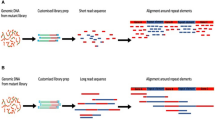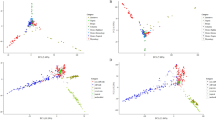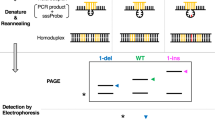Abstract
The development of molecular genetic markers, detecting variation at the DNA level, has opened new horizons in the genetic analyses of both man and agricultural species. Agricultural applications of “Restriction Fragment Length Polymorphisms” (RFLPs), despite their promise, are limited by the formidable costs involved in examining the large populations required. It is the purpose of this contribution to point out that the introduction of oligonucleotide probes into agricultural genetics may provide a solution to the cost problems. Furthermore, the number of detectable “Oligonucleotide Polymorphisms” (OPs) should exceed by an order of magnitude the number amenable to RFLP techniques, thus opening the gates to additional applications.
This is a preview of subscription content, access via your institution
Access options
Subscribe to this journal
Receive 12 print issues and online access
$209.00 per year
only $17.42 per issue
Buy this article
- Purchase on Springer Link
- Instant access to full article PDF
Prices may be subject to local taxes which are calculated during checkout
Similar content being viewed by others
References
Beckmann, J.S. and Soller, M. 1986. From Cloned Genes to Genomic Genetics. In: Expert Consultation on Biotechnology for Livestock Production and Health, FAO, Rome (October 1986, in the press).
Botstein, D., White, R., Skolnick, M., and Davis, R.W. 1980. Construction of a genetic linkage map in man using restriction fragment length polymorphisms. Am. J. Hum. Genet. 32:314–331.
In this procedure DNA is digested by restriction enzymes, the fragments generated are separated by size on a gel, transferred to a solid support, and hybridized to a labeled cloned sequence acting as probe (see ref. 15). Point mutations or small structural changes (e. g. deletions, additions, inversions) in the vicinity of the genomic DNA regions homologous to the probe will affect the length of the fragment containing the probe-homologous sequence. This can be detected as a change—termed an RFLP—in the location of the hybridization band on autoradiography.
Beckmann, J.S. and Soller, M. 1986. Restriction fragment length polymorphisms in plant genetic improvement, Oxford Surveys of Plant Molecular and Cell Biology. 3:196–250. B. J. Miflin, (Ed.). Oxford Press, Oxford.
Soller, M. and Beckmann, J.S. 1982. Restriction fragment length polymorphisms and genetic improvement. In: Proceedings of the Second World Congress on Genetics Applied to Livestock Production (Madrid) 6:396–404.
Soller, M. and Beckmann, J.S. 1983. Genetic polymorphism in varietal identification and genetic improvement. Theor. Appl. Genet. 67:25–33.
Burr, B., Evola, S.V., Burr, F.A., and Beckmann, J.S. 1983. The application of restriction fragment length polymorphism to plant breeding, p. 45–59. In: Genetic Engineering: Principles and Methods, Vol. 5. (J. K. Setlow and A. Hollaender, (Eds.). Plenum Press, New York, NY.
Hallerman, E., Kashi, Y., Nave, A., Beckmann, J.S., and Soller, M. 1987. Restriction fragment length polymorphisms in dairy cattle and their utilization for genetic improvement. Wld. Rev. Anim. Production 22.
Lebowitz, R.J., Soller, M., and Beckmann, J.S. 1987. Trait-based analyses for the detection of linkage between marker loci and quantitative trait loci in crosses between inbred lines. Theor. Appl. Genet. 72:556–562.
Kashi, Y., Soller, M., Hallermann, E., and Beckmann, J.S. 1986. Restriction fragment length polymorphisms in dairy cattle genetic improvement, p. 57–63. In: Proceedings of the Third World Congress on Genetics Applied to Livestock Production, Vol. 12. Nebraska.
Geldermann, H. 1975. Investigation on inheritance of quantitative characters in animals by gene markers. I. Methods. Theor. Appl. Genet. 46:319–330.
Conner, B.J., Reyes, A.A., Morin, C., Itakura, K., Teplitz, R.L., and Wallace, R.B. 1983. Detection of sickle-cell βs-globin allele by hybridization with synthetic oligonucleotides. Proc. Nat. Acad. Sci. U.S.A. 80:278–282.
Kazazian, H.H. Jr. 1985. Gene probes: Application to prenatal and postnatal diagnosis of genetic disease. Clin. Chem. 31:1509–1513.
Erlich, H.A., Horn, G.T., Saiki, R.K., Scharf, S.J., Mullis, K.B., and Bugawan, T. 1986. Genetic analysis using enzymatic amplification of specific genomic sequences, p. 102–107, In: DNA Probes, Current Communications in Molecular Biology, L. S. Lerman (Ed.). Cold Spring Harbor Laboratory, NY.
Southern, E.M. 1975. Detection of specific sequences among DNA fragments separated by gel electrophoresis. J. Mol. Biol. 98:503–517.
Garbutt, G.J., Wilson, J.T., Schuster, G.S., Leary, J.J., and Ward, D.G. 1985. Clin. Chem. 31:1203–1206.
Jeffreys, A.J. 1979. DNA sequence variants in the G-gamma, A-gamma, delta and beta globin genes of man. Cell 18:1–10.
Murray, J.C., Mills, K.A., Demopulos, C.M., Hornung, S., and Motulsky, A.G. 1984. Linkage disequilibrium and evolutionary relationships of DNA variants (restriction enzyme fragment length polymorphisms) at the serum albumin locus. Proc. Nat. Acad. Sci. U.S.A. 81:3486–3490.
Myers, R.M., Larin, Z., and Maniatis, T. 1985. Detection of Single Base Substitutions by Ribonuclease Cleavage at Mismatches in RNA: DNA Duplexes. Science 230:1242–1246.
Myers, R.M., Lumelsky, N., Lerman, L.S., and Maniatis, T. 1985. Detection of single base substitutions in total genomic DNA. Nature 313:495–498.
Church, M. and Gilbert, W. 1984. Genomic sequencing. Proc. Nat. Acad. Sci. U.S.A. 81:1991–1995.
EMBL Nucleotide Sequence Data Library, Release No. 10 (1986).
Wrischnik, L.A., Higuchi, R.G., Stoneking, M., Erlich, H.A., Arnheim, N., and Wilson, A.C. 1987. Length mutations in human mitochondrial DNA: direct sequencing of enzymatically amplified DNA. Nucl. Acid Res. 15:529–541.
Bar-Joseph, M., Segev, D., Blickle, W., Yesodi, V., Franck, A., and Rosner, A. 1986. Application of synthetic DNA probes for the detection of viroids and viruses, p. 13–23. In: Developments in Applied Biology. Jones, R. A. C. and Torrance, L. (Eds.). Assoc. of Applied Biologists, Warwick, U. K.
Stam, P. and Zeven, A.C. 1981. The theoretical proportion of the donor genome in near-isogenic lines of self-fertilizers bred by back-crossing. Euphytica 30:227–238.
Author information
Authors and Affiliations
Rights and permissions
About this article
Cite this article
Beckmann, J. Oligonucleotide Polymorphisms: A New Tool for Genomic Genetics. Nat Biotechnol 6, 1061–1064 (1988). https://doi.org/10.1038/nbt0988-1061
Issue Date:
DOI: https://doi.org/10.1038/nbt0988-1061
This article is cited by
-
Analysis of evolutionary relationship betweenAstasia longa andEuglena gracilis by using RAPD Technique and cladistic analysis
Chinese Journal of Oceanology and Limnology (2001)



